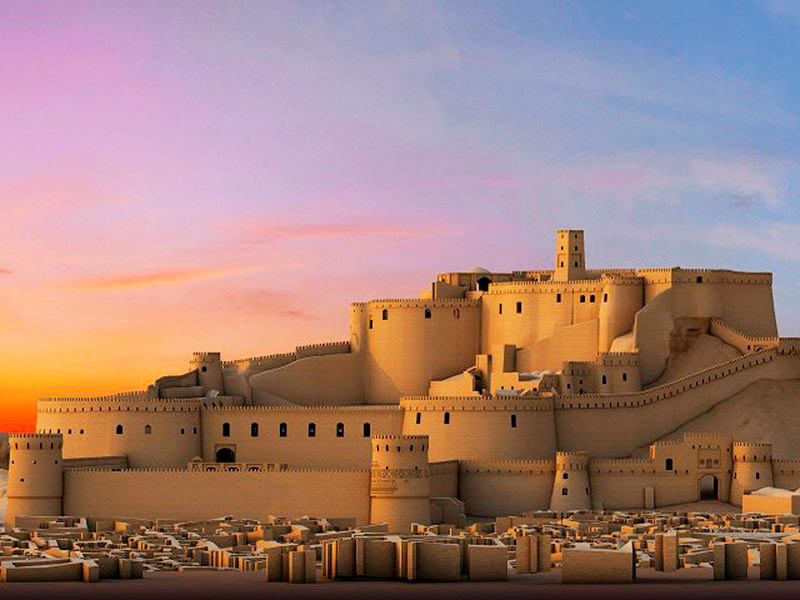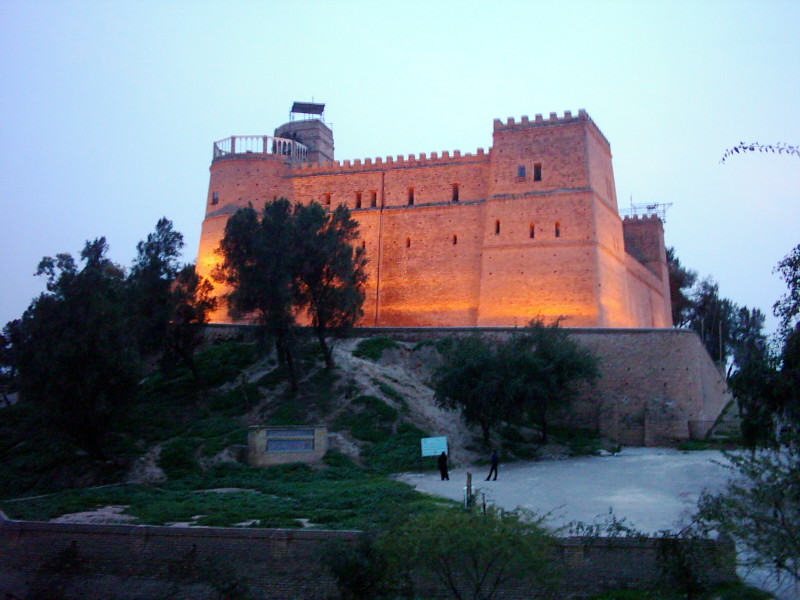
Iran’s history is full of ups and downs and has witnessed many invasions and wars throughout history. This justifies the need for strong forts and castles in this country. “Arg” is a small castle within a larger castle and is dedicated to administrative affairs. It is the place where kings and rulers were living along with their families. Forts are among the oldest structures in Iran.
- Falak-ol-Aflak Citadel (Shapur Khast) is among the most reputed structures built during the Sassanid era in Khorramabad city of the Lorestan province. It was built 1800 years ago and is located on a stony hillock. It was known as “Shahpour Khast” before the Qajar era. When you enter, there is a corridor with chambers on the west and the east. The corridor leads to the courtyard. There are eight chambers in the northeastern part of the corridor which lead to a yard having a well that is used to provide water for the inhabitants. The second courtyard runs in an east-west direction with sixteen chambers. To the northeast of the castle is a corridor that leads to a dark room most probably a prison cell. During the Pahlavi reign, this castle was used as a prison for political prisoners. Today, part of this relic has been converted into a museum.
- Rudkhan Castle (Ghaleh Roodkhan) is situated amid greenery, 20 kilometers southeast of Fouman in Gilan Province. You can access it by walking and climbing the trail passing through the spectacular intact jungle for two hours. There are no cars on the path. This fort is in good shape for its remoteness in the olden days as there were no such modes of transportation back then. Something interesting about this fort is that parts of it have undergone degradation and become part of the jungle. A natural spring flows from one tip down the foothills. There are 65 towers of which 42 still stand intact. The castle has two sections: one administrative and the other military. Experts believe the existing castle dates back to the Seljuk Era (1037-1187 CE), however, there is evidence of Sassanid architecture (226-651 CE) in the castle. This castle has a massive entrance gate, among the interesting features are the geometric works of masonry which demonstrate the skills of the architects one thousand years ago.
- Alamut Castle is perched on top of a steep hill. It was once sheltering the followers of Hasan-e-Sabbah (1070-1124), the spiritual leader of a heretical Ismaili sect that spawned the word ‘Assassins’. Situated on the northeastern side of Gazor Khan Village in the vicinity of Alamut, Qazvin province. Visitors approach the village and pass along a narrow road surrounded by cherry and pomegranate orchards until they see the gray-brown rock from distance. The path to the fortress starts 700m from the village and is a steep 25-minute climb via s stairway. Alamut means “eagle’s nest”, a region on the western edge of the Alborz Mountain range, between the barren plain of Qazvin in the south and the densely forested slopes of Mazandaran province in the north. The Mongols destroyed most Ismaili records during the time of Sabah’s rule over Alamut, while their detractors’ writings survived. Visitors leave Tehran first thing in the morning for Qazvin, and go across Alamut’s first ramparts, then heading up the valley, reach Gazorkhan in time for a late lunch.
Read more: Alamut Castle and Ovan Lake
- Takht -e- Soleiman meaning “throne of Solomon” is an archeological site in north-western Iran, situated in a valley set in a volcanic mountain region. The site includes the main Zoroastrian sanctuary rebuilt in the Ilkhanid (Mongol) period (13th century) and also a temple of the Sasanian period (6th and 7th centuries) dedicated to Anahita. It has important symbolic significance related to fire and water. The general layout has strongly influenced the development of Islamic architecture. In addition to the historical remains of the Azargoshtasp fire temple around a magical lake at the center of the complex, and 38 towers on the stony plates made from the sediments of the lake, there are some natural settings here: Soleyman Prison Mountain, Belqeis castle, and remains of the Anahita temple, hot springs.

Castles in Iran – Castles are major tourist attraction points
- Narenj (Narin) castle is in Naein city in Isphahan province and is one of the most important relics of the province dating back to the period before the advent of Islam. On your way to Isfahan from Yazd, you will be passing by Nain. Be sure to stop and visit Narenj Castle! This ancient castle has been constructed on the top of Galeen hill and overlooks the city. The upper floors of the building have been reconstructed and belong to the Islamic era. A section of the building was destroyed in the course of road construction in the reign of Pahlavi II. This castle is eroding but you can still delineate its features. The journey from the Jame’ mosque to the fort bypasses a set of impressive wind towers.
- Birjand castle is in the east Iranian provincial capital of South Khorasan. It is located on the “silk road”. The city has a dry climate with a significant difference between day and night temperatures. It has four corners and two towers on the western and eastern sides, it has two entrances on the north and west sides. The castle dates back to the Safavid period and was built from mudbricks. From the Safavid period to Qajar, the people of this city were protected against the invasion of enemies, especially Turkmen and Uzbek. This castle was completely rebuilt and used in the Qajar period. According to evidence, the castle was linked to the city’s major hubs by underground graves.
- Arg of Karim Khan is a citadel located in Shiraz. It dates back to the period before Karim Khan, but after Karim Khan chooses Shiraz as the capital of his kingdom. King of Zand ordered the best architects of that time to build it. At first glance, we could understand the strength and stability of the building. It has watchtowers which were for the soldiers to protect the citadel. As a residential place for Karim Khan, the building had to be protected from enemies. It has rooms called “shahneshin” and a bathhouse. When the first Qajar king gained power, the building became the local governor’s house.
- Qeshm Portuguese Castle was built in 1030 AH. This red castle is one of the few surviving monuments from the time that the Portuguese ruled in the Persian Gulf. Qeshm is the gate of the Persian Gulf; so, at that time, it was an important strategic place and marine city. To the northeast of this Island in the Persian Gulf under a decree of the Spanish monarch of the time. This castle has two ramparts and towers in the four corners. Within the castle, several extremely ancient canons remain to date. It was constructed under the orders of Afonso de Albuquerque, the Portuguese conqueror, and includes weapon caches, a great cistern, barracks, prisons, churches, and halls. The Portuguese castle is one of the attractions in Hormozgan Province.
Read more: Best autumn destinations in Iran for adventurers
- In the southern reaches of Iran, on a vast desert plateau, the Bam Citadel rises again after being almost completely destroyed in the 2003 Bam earthquake. Its origins are traced back to the 6th century BC in the Achaemenid period, the oasis town and citadel of Bam experienced its golden era in the 7th until 11th centuries when it was one of the key stops on the Silk Route. It is awarded UNESCO World Heritage Status after the devastating earthquake of 2003, heritage experts from Iran and abroad have worked tirelessly to restore the cultural landscape of Bam of which the Bam citadel is only one small part. There is plenty of interesting spots to see with Arg-e-Bam to ensure an incredible visit. Be sure to experiment with the courtyard’s unique acoustic characteristics. Visitors can see the governor’s house at the highest point of the citadel of Bam including baths and a pavilion.
- Rayen Citadel is one of the greatest examples of historical adobe buildings in the world. It is located in central Iran and its wonderful architecture captivates visitors. Originally built in the Kerman province during the Sassanid era, this amazing structure still stands tall in the skirts of Hezar Mountain and leaves any visitor with a sense of awe and admiration, studies show that the current structure is built over the ruins of an older castle and has gone through many renovations and reconstructions. In Arg -e- Rayen, the best architecture and locations are dedicated to the richer people of this society and were protected with fences and walls. The astonishing architecture of this castle as well as its unique location will amaze you. Try not to miss it during your trip to Iran!

Castles in Iran – Susa castle
Many castles belonging to the Ismailis were taken and demolished by the Mongols, but the ruins still give an impression of their immense power. The Ismaili fortresses are notable examples of military architecture. There are also other castles, including Atashgah castle, Babak castle, and Shush castle, which are less known.
Shush castle is located on a hill in Shush and dates back to the Qajar era (1785-1925). The castle was constructed in 1897 by French archaeologist Jacques de Morgan as a base to house him and his team. He transferred bricks from Apadana palace and Chogha Zanbil Ziggurat and transferred them to this site to construct his base.
Atashgah (fire temple) castle is 12km northwest of Kashmar city in Khorasan Razavi Province. This castle was built by the Sasanian government, and it is a historical remnant belonging to the Sassanian era. It was famous in ancient times. Nearby the fire temple, a large cave exists, near the entrance of which a statue of a mounted soldier with a sword is noted.
Read more: Winter destinations in Iran
On top of a mountain, Babak Castle is a strong and massive fortress that was built to commemorate the Azeri heroes of Iran’s struggles. Babak Khorramdin was the main leader of the Iranian fighters who revolted against the Abbasid caliphate after the death of Abu Muslim.
Are you planning to travel to Iran and looking for some adventure? Check out our Iran Climbing & Trekking Tours, Iran Ski Tours, Iran Desert Tours & Iran Cycling Tours.
